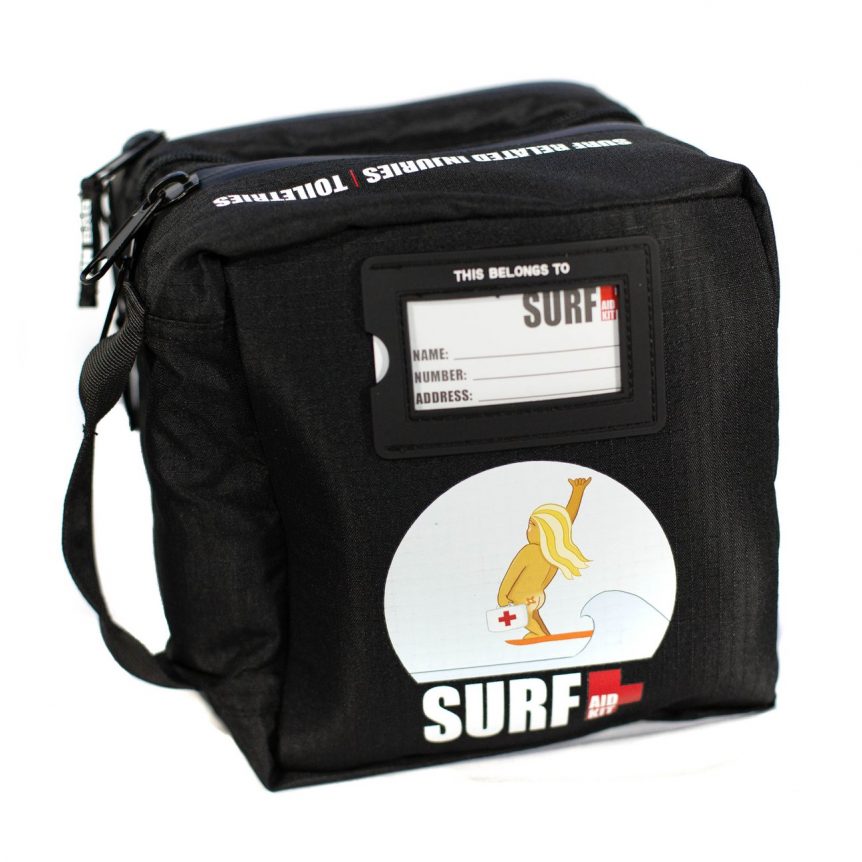Surfing has become a very popular sport, covering all levels and age groups, and is mostly regarded as a safe sport, compared to many others, with a low overall risk of injury. Most injuries are not serious and can be treated easily, so let’s have a look at the most common surfing injuries.
Surfers most often sustain injuries to the leg, the head and face, the back, and the shoulder and arm. The main cause of injury is contact with a surfer’s own board or someone else’s board. ‘Wiping out’ and striking the seabed are also common causes of injury.
We do recommend some basic preparation to prevent injury, for example a good warm up and cool down routine being part of every surf session is important. Being aware of the surf etiquette, knowing your local break and using equipment that suits your levels are also essential to keep it safe.
Common injuries from surfing include:
- lacerations like cuts and scrapes
- sprains
- surfer’s ear
TREATING LACERATIONS
- Rinse with freshwater (add soap if you have it) and use our tweezers or needle to remove any foreign bodies (reef, sand, dirt, fibreglass)
- Clean the wound EXTENSIVELY (e.g. Alcohol wipes, Hydrogen Peroxide, Lime, Dettol, vinegar)- this is critical because reefs and oceans are packed with bacteria and pathogens.
- Rinse again and make sure any dead skin is removed to avoid bacteria grow under it.
- Apply an antiseptic (highly recommend betadine) and cover the wound with a large sticky band aid.
- Clean and redress the wound at least 2-3 times per day and avoid dirt getting in.
- “Letting a wound breathe” can be harmful if bacteria get in and also it can lead to the new cells dying (wound feels tight and pain increases) you want the wound to be moist but not wet! We recommend using a Roll of Non-Woven adhesive after the first couple of days and changing this frequently.
- For pain and swelling we recommend that you carry an anti-inflammatory such as ibuprofen on your surf trips. If you are going somewhere really remote you could also get a general antibiotic or an antibiotic cream.
- Avoid dirty water or ocean water entering any open wound. If you can’t resist you can always try covering the wound with vaseline AND/OR strapping around the already dressed wound with duct tape…
TREATING SPRAINS
Surfing, at any level and even for a short period of time, can be a solid workout.
It’s important to identify the type of soreness after a surf session. Quite often we rely on our senses to tell us if what we are feeling is “normal”. So, what if this time it hurts just a little more or isn’t quite the same type of pain you are used to? Unless the pain unbearable (in that case you should seek medical attention immediately) you should look for these signs and symptoms
- - Intense pain
- - Restricted movement of the injured joint
- - Rapid development of swelling and bruising
- - Sharp sudden pain in the region of the injury
- - Loss of power
- - Muscle tenderness
If any of these signs or symptoms have occurred or you are unsure, then follow RICER and avoid HARM:
Follow RICER
- Rest, don’t push through at this point!
- Ice it for the initial acute pain and this should be done by applying for 20mins every 2 hours
- Compression should be light, use a pressure bandage, make sure you are comfortable, and it isn’t too tight
- Elevate the injured part if possible
- Referral, if it is really bad then you may need to seek medical aid or advice on the best road to recovery
Avoid HARM
- Heat should be avoided initially; it could be good in in a few days’ time but only once the acute pain has had time to settle down
- Alcohol should also be avoided this enhances blood flow which is what you are trying to slow down while acute pain is still there
- Running or exercise that is going to further damage injured area
- Massages again just avoid these while the acute pain is still there (first few days)
TREATING SURFERS EAR
Some key points:
- It is an extra bone growth (exostosis) in the ear canal usually caused by the repeated exposure to cold water and/or wind.
- This bone growth causes ear canal to be narrowed which means you are more likely to get an ear infection as water is trapped more easily
- Water temperature around 20 °C stimulates bone growth
- Time taken for surfers’ ear to develop changes from person to person and depends on how cold and how exposed you are.
- It is very common! Lots of people have it. Most people notice it when they travel from colder climates to warmer places and get ear infections.
- Surfer’s ear is different to swimmers’ ear: swimmers’ ear is an infection not bone growth
Symptoms:
- None in early stages
- As the condition develops you may notice water getting stuck in ear more often after a surf or an increase in ear infections
- Decreased hearing or hearing loss, temporary or ongoing
- Increased prevalence of ear infections, causing ear pain
- Difficulty evacuating debris or water from the ear causing a plugging sensation
Treatment:
The best treatment for surfer’s ear is prevention (wear ear plugs, a hat with ear flaps, avoid the cold water). But for those beyond saving, there is a treatment option: surgery.
- Surgeon drills out the bone growth, involves cutting and stitching ear and results in several weeks out of the water OR some surgeons have a chiselling technique which is doesn't require ear to be cut so recovery time is shorter!
Check out the awesome first aid kit specifically developed for surfers. This kit doesn’t only covers first aid specifically for surfers, but also has room for your surfing hardware, fins and toiletries. It is a one stop shop for any surf trip allowing you to keep everything packed away neatly, labelled and in the one place.
Special thanks to the SURF AID KIT team for delivering the resources and designing a fantastic product to keep us safe. Make sure you check out their website and support the team www.surfaidkits.com.au

